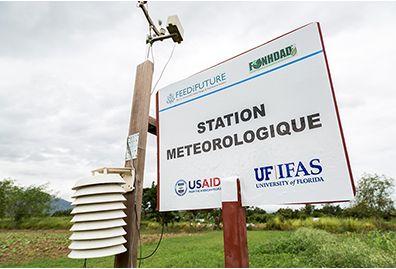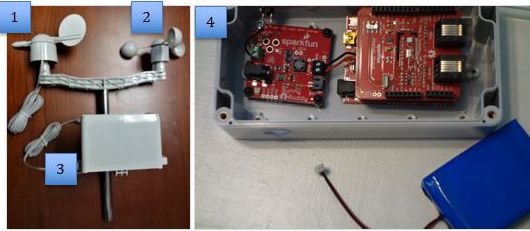Introduction
Weather can significantly influence the success or failure of agricultural enterprises. Monitoring weather conditions can provide critical decision-making information. Farmers recognize this, so they routinely look at weather reports and forecasts to help them make decisions related to irrigation, cold protection, and many other applications. In Haiti, there are generally very few weather stations, most of which are located in urban areas. Weather conditions in Haiti can be highly variable, even over a distance of a few kilometers. Therefore, weather data from a station in the city are not likely to be representative of the conditions on or near a farm. As weather monitoring technology becomes more affordable, many farmers are choosing to build and install their own weather stations to monitor weather conditions on their farms. The installation of a weather station provides farmers with a unique opportunity to better understand how weather conditions influence their crops and livestock, but on a much more localized level than general weather reports can provide. This publication provides Haitian farmers with basic guidelines for installing and maintaining an on-farm weather station.

Credit: Remixon Guillaume
Choosing Weather Station Instrumentation
Choosing instrumentation for a weather station depends on its intended purpose. To ensure a station will meet the intended need, users should first identify how the weather data from the station might be used. For example, if scheduling irrigation is important, estimating evapotranspiration (ET) will be necessary. Estimating ET requires a specific set of variables including solar radiation, wind speed, relative humidity, and air temperature. Also, the wet bulb temperature can play an important role in decisions related to freeze protection. A grower who is concerned about freeze protection would want to ensure his/her weather station is capable of providing this measurement. If simply monitoring the overall weather of the farm is desired, a station equipped with a rain gauge, temperature sensor, humidity sensor, and anemometer (to measure wind speed and direction) may suffice.
Choosing the Weather Station Location
Selecting an appropriate site for your weather station is critical to obtaining useful weather observations. For agricultural applications, the station should be located in a place that best represents field conditions. Stations located at an airport or in an urban environment are often not appropriate for agricultural applications. For example, these environments are typically very developed with concrete and asphalt, and these materials can influence temperature readings. In addition, rainfall can be highly variable, even over a short distance. Therefore, a weather station that is located away from the field may not provide representative rainfall measurements. Weather stations should ideally be placed over a surface that is representative of the field (e.g., grass or some other natural surface) and as far from obstructions, such as buildings and trees, as possible. Below are some sensor location guidelines from weather station manufacturer Campbell Scientific:
a. Wind speed and direction: Wind sensors should be located over open, level terrain as far away from any nearby obstructions (e.g., buildings, trees, etc.) as possible—ideally a distance equal to 10 times the height of the closest obstruction;
b. Temperature and relative humidity: Temperature and relative humidity sensors should be located over an open, level area at least 10 m (about 30 ft) in diameter. The surface should be covered with short grass or another natural surface. These sensors should be located a distance of at least four times the height of any nearby obstruction, or at least 30 m (about 100 ft) from large paved areas. Sensors should be encased within a well-ventilated shield for protection from thermal radiation. Rooftops, steep slopes, high vegetation, shaded areas, swamps, low places that hold standing water after rains, and large industrial heat sources should be avoided;
c. Solar radiation: Sensors should be mounted on the southernmost (in the Northern Hemisphere) side of the station to prevent exposure to shadows. Reflective surfaces and artificial radiation sources should be avoided. Ensure tall trees and/or other structures will not shade the sensor as the angle of the sun changes throughout the year;
d. Rain gauge: Rain gauges should be placed as far away from obstructions as possible—ideally at a distance equal to four times the height of the closest obstruction. The collector of the rain gauge must be in a horizontal plane, level, open to the sky, and above the height at which splashing rain and snow accumulation can influence the measurement.

Credit: William Eisenstadt, UF
Maintaining the Weather Station
When weather stations are not properly maintained, the data generated may be not be useful for the intended purpose. For example, if a rain gauge is not periodically cleaned out, the opening may become clogged, and this would prevent the gauge from properly measuring rainfall. In addition, a dirty solar panel can cause the weather station to lose power. Table 1 provides some general maintenance recommendations for several common sensors.
Conclusion
Location-specific weather data have many applications. Accurately scheduling irrigation, for example, is very difficult, if not impossible, without reliable weather data. An on-farm weather station can help farmers keep track of temperature and humidity to avoid heat stress, watch overnight temperature changes, and more. Proper installation, siting, and maintenance of a weather station are imperative and will ensure the station is collecting data that are useful across many applications.
References
Arizona Cooperative Extension. 2010. "Siting and maintenance of weather stations." Accessed May 17, 2019. https://extension.arizona.edu/sites/extension.arizona.edu/files/pubs/az1260.pdf
Brown, P. and B. Russell. 2010. "Siting and maintenance of weather stations." Turf Irrigation Management Series III. College of Agricultural and Life Sciences. AZ 1260.
Campbell Scientific. 2019. "Weather station siting." Accessed May 17, 2019. http://www.campbellsci.com/weather-station-siting
Citizen Weather Observer Program. 2009. "Radiation shields to reduce error." Accessed May 17, 2019. http://wxqa.com/shields.html
Fraisse, C. W., G. W. Braun, W. R. Lusher, and L. R. Staudt. 2014. Your Farm Weather Station: Installation and Maintenance Guidelines. AE502. Gainesville: University of Florida Institute of Food and Agricultural Sciences. https://edis.ifas.ufl.edu/ae502
National Weather Service. 2016. "Personal Weather Station—Siting." Accessed May 17, 2019. https://www.weather.gov/media/epz/mesonet/CWOP-Siting.pdf
Weather Station Advisor. 2019. "How weather stations can help farmers." Accessed May 17, 2019. https://www.weatherstationadvisor.com/weather-stations-can-help-farmers/